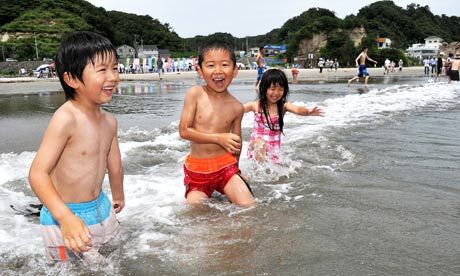
Local authorities decided to open Nakoso beach, located just 65km (40 miles) south of the stricken plant, after declaring the water safe. Radiation doses in the air were also low, at up to 0.07 microsieverts an hour, far below those considered a threat to health.
On Monday, which was a national holiday held to celebrate the ocean, about 1,000 people, including young families, headed to the beach for the first time in two summers.
"The water's still cold, but it's going to be a good season," Yukiei Hakozaki, a local guide, told Kyodo News. "We want lots of people to come."
All 17 beaches in Fukushima prefecture, a popular surfing spot, were closed last summer amid concern over contamination from the power plant and debris created by the tsunami on 11 March, in which almost 20,000 people died.
According to the local authorities, the concentration of radioactivity in the water is negligible, at below 1 becquerel per litre, and poses no risk to the health of sunbathers and swimmers. Radiation readings are displayed on the beach twice a day.
Nakoso, the prefecture's southernmost beach, will have to accommodate local holidaymakers alone for the time being, as there are no plans to reopen other beaches in the area.
While sunseekers in Fukushima marked the day with music, hula dancing and beach volleyball, tens of thousands of people marched in Tokyo calling for the closure of all of Japan's nuclear power plants.
Organisers estimated that 170,000 people crammed into Yoyogi park in the capital, while the police put the figure closer to 75,000.
The demonstration was part of a campaign to put pressure on the prime minister, Yoshihiko Noda, into reversing his decision to restart two nuclear reactors in western Japan to avoid possible power cuts this summer.
One reactor at Oi power plant in Fukui prefecture was restarted earlier this month, while the second is expected to go back online later this week.
The march was led by the Nobel literature laureate Kenzaburo Oe, who told the crowd: "The government allowed the Oi nuclear reactors to restart and it's going to allow more reactors to restart. We feel we have been insulted by the government."
Oe, along with the composer and musician Ryuichi Sakamoto and other activists, is putting together a petition of 10m signatures demanding an end to Japan's use of nuclear power. The group has already collected more than 7.5m signatures.



Comment:
Record radiation levels detected at Fukushima reactor
Japan's Battered Fukushima Nuclear Plants - A Global Catastrophe Waiting To Happen?
Fukushima Daiichi: The Truth and the Future
Nuclear Peril: Why Fukushima is a Greater Disaster Than Chernobyl
Houston We Have a Problem, No Known Technology to Deal with Fukushima
The Worst Yet to Come? Why Nuclear Experts Are Calling Fukushima a Ticking Time-Bomb
The Fukushima Nuclear Disaster Is Far From Over